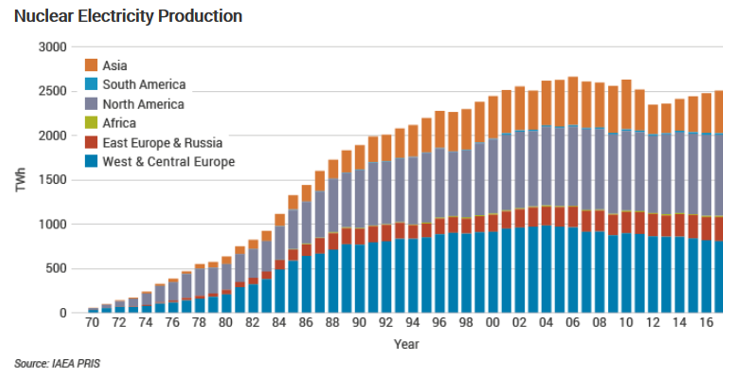Nuclear Energy
Massachusetts Institute of Technology researchers have released a report titled the MIT Energy Initiative (MITEI). The authors of the study assert that unless nuclear energy is included in the mix of low-carbon energy, avoiding dangerous climate change will be more difficult and costly. But the authors note a “current global stall of nuclear energy capacity.” Nuclear power accounted for about 10% of total electricity production in 2017, down from 16-17% in the 1980s, and total electricity demand increased faster than nuclear-generated electricity. Concern over reactor cost, safety, waste disposal and other environment considerations slowed development of new nuclear energy reactors. Replacement and upgrade of existing reactors boosted production of nuclear electricity well into the new century. That trend reversed in 2011 following the March 11th tsunami that flooded three nuclear reactors at Japan’s Fukushima Daiichi plant. Japan’s government backed away from nuclear energy due to safety concerns, but projections of energy demand required nuclear to remain in the mix. As of the beginning of 2019 Japan had brought nine nuclear reactors back on line, and 17 more were in the approval process. Although Germany decided to phase out nuclear power generation by 2022 in response to Fukushima, planning and construction for new nuclear reactors continues in other countries. There are about 450 operational nuclear power reactors in 30 countries worldwide, and about 60 are under construction. The additions represent about a 15% increase in electricity generation. Total demand for electricity worldwide is projected to double by 2050. About 65% of electricity is currently produced from burning of fossil fuels. The International Panel on Climate Change states that no more than 20% of the world’s electricity can be high-carbon-emitting by 2050 if global warming reduction goals are to be met. Advances in nuclear technology offer hope. Alternative coolants, reduction and reuse of nuclear waste, small factory-built reactors, safer designs, and the holy grail of nuclear fusion rather than fission, look to solve the challenges of cost competitiveness, safety and safe waste disposal, and put within reach the cap on temperature that will keep the planet habitable. According to MITEI, nuclear energy must play a role.
